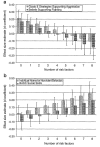The multisite violence prevention project: impact of a universal school-based violence prevention program on social-cognitive outcomes
- PMID: 18780181
- PMCID: PMC2748309
- DOI: 10.1007/s11121-008-0101-1
The multisite violence prevention project: impact of a universal school-based violence prevention program on social-cognitive outcomes
Abstract
This study evaluated the impact of a universal school-based violence prevention program on social-cognitive factors associated with aggression and nonviolent behavior in early adolescence. The effects of the universal intervention were evaluated within the context of a design in which two cohorts of students at 37 schools from four sites (N = 5,581) were randomized to four conditions: (a) a universal intervention that involved implementing a student curriculum and teacher training with sixth grade students and teachers; (b) a selective intervention in which a family intervention was implemented with a subset of sixth grade students exhibiting high levels of aggression and social influence; (c) a combined intervention condition; and (d) a no-intervention control condition. Short-term and long-term (i.e., 2-year post-intervention) universal intervention effects on social-cognitive factors targeted by the intervention varied as a function of students' pre-intervention level of risk. High-risk students benefited from the intervention in terms of decreases in beliefs and attitudes supporting aggression, and increases in self-efficacy, beliefs and attitudes supporting nonviolent behavior. Effects on low-risk students were in the opposite direction. The differential pattern of intervention effects for low- and high-risk students may account for the absence of main effects in many previous evaluations of universal interventions for middle school youth. These findings have important research and policy implications for efforts to develop effective violence prevention programs.
Figures


References
-
- Aber JL, Jones SM, Brown JL, Chaudry N, Samples F. Resolving conflict creatively: Evaluating the developmental effects of a school-based violence prevention program in neighborhood and classroom context. Development and Psychopathology. 1998;10:187–213. doi:10.1017/S0954579498001576. - PubMed
-
- Boxer P, Dubow EF. A social-cognitive information-processing model for school-based aggression reduction and prevention programs: Issues for research and practice. Applied & Preventive Psychology. 2002;10:177–192. doi:10.1016/S0962-1849(01)80013-5.
-
- Boxer P, Goldstein SE, Musher-Eizenmann D, Dubow EF, Heretick D. Developmental issues in school-based aggression prevention from a social-cognitive perspective. The Journal of Primary Prevention. 2005a;26:383–400. doi:10.1007/s10935-005-0005-9. - PubMed
-
- Boxer P, Guerra NG, Huesmann LR, Morales J. Proximal peer-level effects of a small-group selected prevention on aggression in elementary school children: An investigation of the peer contagion hypothesis. Journal of Abnormal Child Psychology. 2005b;33:325–338. doi:10.1007/s10802-005-3568-2. - PubMed
-
- Cohen J. Statistical power analysis for the behavioral sciences. 2nd ed. Erlbaum; Hillsdale, NJ: 1988.
Publication types
MeSH terms
Grants and funding
LinkOut - more resources
Full Text Sources
Medical

